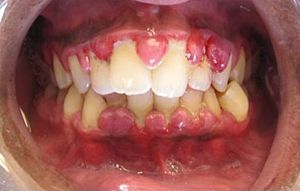Gingival hyperplasia
| Gingival enlargement | |
|---|---|
 |
|
| Gingivitis, a common cause of inflammatory gingival enlargement. | |
| Classification and external resources | |
| Specialty | gastroenterology |
| ICD-10 | K06.1 (ILDS K06.100) |
Gingival enlargement, (also termed gingival overgrowth, hypertrophic gingivitis, gingival hyperplasia, or gingival hypertrophy, and sometimes abbreviated to GO), is an increase in the size of the gingiva (gums). It is a common feature of gingival disease. Gingival enlargement can be caused by a number of factors, including inflammatory conditions and the side effects of certain medications. The treatment is based on the cause. A closely related term is epulis, denoting a localized tumor (i.e. lump) on the gingiva.
The terms gingival hyperplasia and gingival hypertrophy have been used to describe this topic in the past. These are not precise descriptions of gingival enlargement because these terms are strictly histologic diagnoses, and such diagnoses require microscopic analysis of a tissue sample. Hyperplasia refers to an increased number of cells, and hypertrophy refers to an increase in the size of individual cells. As these identifications obviously cannot be performed with a clinical examination and evaluation of the tissue, the term gingival enlargement is more properly applied. Gingival enlargement has been classified according to cause into 5 general groups:
Gingival enlargement may be caused by a multitude of causes. The most common is chronic inflammatory gingival enlargement, when the gingivae are soft and discolored. This is caused by tissue edema and infective cellular infiltration caused by prolonged exposure to bacterial plaque, and is treated with conventional periodontal treatment, such as scaling and root planing.
...
Wikipedia
